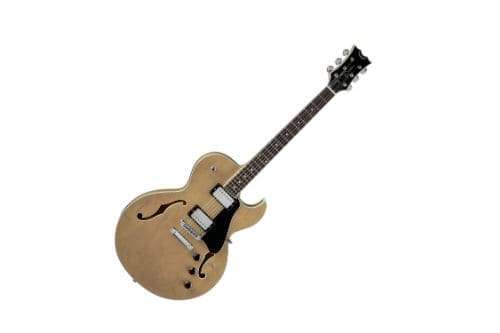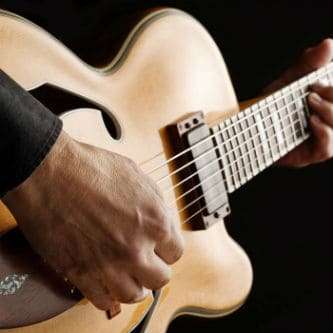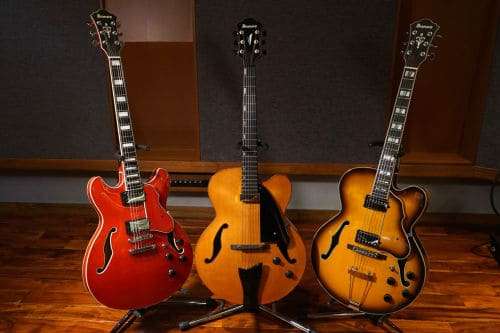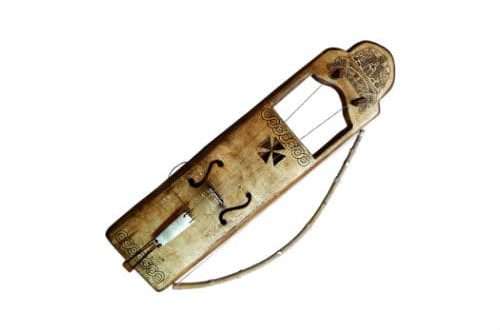
Semi-acoustic guitar: instrument features, history, types, use
Contents
Since its inception, the guitar has gained popularity among musicians working in different genres. The evolution of a musical instrument has led to the emergence of new types, and a semi-acoustic has become a transitional option between acoustic and electric guitar. It is equally actively used as performers of pop, rock, metal, folk music.
What is the difference between a semi-acoustic guitar and an electro-acoustic guitar?
Novice performers uninitiated in musical subtleties often confuse these two types, but in fact their difference is fundamental. An electric guitar is mistaken for semi-acoustic because of the common additional elements: pickups, volume controls, timbre, and the ability to connect to a combo amplifier.
The main difference between an electro-acoustic guitar and a semi-acoustic guitar is in the structure of the body. In the second case, it is hollow, like a conventional classical guitar, or semi-hollow.
To increase sustain, empty cavities are created around the solid middle. Effs are cut out in the side parts, the width of the body is narrower than that of the first version, the sound is bright and sharp.

Another difference is that the electric guitar cannot be played without being connected to an audio amplifier. Therefore, it is absolutely not suitable for bards and street musicians. The sound of the instrument occurs due to the transformation of string vibrations into vibrations of electric current.
Advantages of semi-acoustic guitar:
- the ability to deliver a clear sound even in a polyphonic mix;
- lighter weight than a hollow body electric guitar;
- a variety of styles, experiments with appearance do not spoil the sound;
- the admissibility of a complete set of various pickups.
A semi-acoustic guitar is a 2 in 1 instrument. That is, it can be used both when connected to an electric current source and without it, like ordinary acoustics.
History
A great contribution to the emergence and popularization of semi-acoustic guitars was made by the American company Gibson, the largest brand that produces musical instruments. By the 30s of the last century, musicians faced the problem of insufficient volume of acoustics. This was especially felt by members of jazz bands and large orchestras, in which the guitar “sank”, lost in the rich sound of other instruments.
The manufacturer made an attempt to amplify the sound by connecting the acoustics to an electric loudspeaker. F-shaped cutouts appeared on the case. The resonator box with efs gave a richer sound, which could be amplified with a pickup. The sound became clear and loud.
Few people know that Gibson did not set out to create a semi-acoustic guitar. Experiments with it were only a test of the feasibility of production and serial production of electric guitars with a solid body.

The musicians appreciated the convenience of solid-body instruments, but among them there were also many fans of guitars with a traditional type of acoustics. In 1958, the company released a “semi-hollow body” series with a semi-hollow body.
In the same year, another manufacturer, Rickenbacker, made its own adjustments to the model that was gaining popularity, smoothing out the cutouts and decorating the case with a laminated coating. Pickups became universal, mounted in different models.
Types
The experiments of manufacturers have led to the emergence of a number of varieties of semi-acoustic guitars:
- with a fully integral body;
- with a solid block, around which wooden plates are built on, a distinctive feature is a bright sound;
- cavity with efs – have a velvety timbre and a short sustain;
- archtop guitars with weak acoustic abilities;
- jazz – completely hollow, designed to be played through an amplifier.
Modern manufacturers are still making adjustments to the structure of the acoustic guitar. They concern not only structural elements, but also external design and style. So, instead of the traditional f-shaped holes, semi-acoustics can have “cat’s eyes”, and the semi-hollow body is made in the form of bizarre geometric shapes.

Using
Jazz performers were the first to appreciate all the advantages of the instrument. They liked the warm, clear sound. Less voluminous than an acoustic guitar body made it easy to move on stage, so it was quickly adopted by pop musicians. In the early 70s, semi-acoustics already actively competed with electric “relatives”. It became the favorite instrument of John Lennon, B.B. King, it was used by famous representatives of the Pearl Jam grunge movement.
The tool is suitable for beginners. Playing does not require a strong impact on the strings, even a light touch makes them respond with a velvety, soft sound. And the possibilities of semi-acoustics allow you to perform improvisations in different styles.





